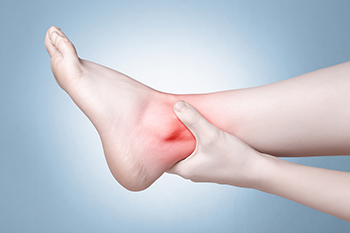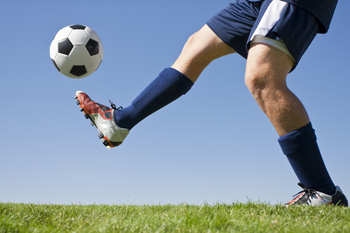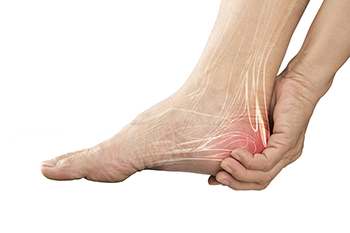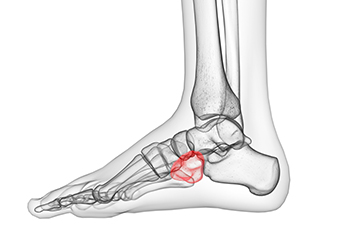Items filtered by date: July 2022
Ganglion Cysts Can Sometimes Cause Ankle Pain

Fluid-filled ganglion cysts are benign masses that can develop in tissue surrounding a tendon as well as in other locations. Ganglion cysts in the feet can occur on top of the foot or in the ankle and are sometimes visible on the skin. If they press against a tendon, joint, or footwear, they can be painful. It is a good idea to have your podiatrist evaluate and diagnose any growth that is causing pain in your ankle or elsewhere on your feet whether or not you suspect a ganglion cyst. They will typically monitor the growth and may prescribe custom orthotics or footwear modifications to alleviate pressure being placed on it. If the cyst becomes overly painful or bothersome, your podiatrist may try aspirating it or using steroid injections to shrink it. A surgical treatment may prove beneficial if the cyst returns or is non-responsive to more conservative treatments.
Ankle pain can have many different causes and the pain may potentially be serious. If you have ankle pain, consult with Jordan S. Steinberg, DPM from Florham Park Podiatry . Our doctor will assess your condition and provide you with quality foot and ankle treatment.
Ankle pain is any condition that causes pain in the ankle. Due to the fact that the ankle consists of tendons, muscles, bones, and ligaments, ankle pain can come from a number of different conditions.
Causes
The most common causes of ankle pain include:
- Types of arthritis (rheumatoid, osteoarthritis, and gout)
- Ankle sprains
- Broken ankles
- Achilles tendinitis
- Achilles tendon rupture
- Stress fractures
- Tarsal tunnel syndrome
- Plantar fasciitis
Symptoms
Symptoms of ankle injury vary based upon the condition. Pain may include general pain and discomfort, swelling, aching, redness, bruising, burning or stabbing sensations, and/or loss of sensation.
Diagnosis
Due to the wide variety of potential causes of ankle pain, podiatrists will utilize a number of different methods to properly diagnose ankle pain. This can include asking for personal and family medical histories and of any recent injuries. Further diagnosis may include sensation tests, a physical examination, and potentially x-rays or other imaging tests.
Treatment
Just as the range of causes varies widely, so do treatments. Some more common treatments are rest, ice packs, keeping pressure off the foot, orthotics and braces, medication for inflammation and pain, and surgery.
If you have any questions, please feel free to contact our office located in Florham Park, NJ . We offer the newest diagnostic and treatment technologies for all your foot care needs.
Common Soccer Injuries of the Feet, Ankle, and Lower Leg

Soccer players can sustain foot, ankle, and lower leg injuries that are either traumatic (collisions, knocks, falls, etc.) or due to repetitive strains on tissues, joints, and muscles. A common traumatic injury in soccer is an ankle sprain—where the ligament(s) in the ankle stretch excessively or tear. An Achilles tendon rupture is another acute injury where this tendon—which attaches the calf muscles to the heel—partially or fully tears. Also, when running or jumping, a soccer player’s lower leg muscle can sometimes pull away from the Achilles tendon. Examples of overuse injuries include plantar fasciitis, which is an inflammatory condition causing heel pain, Achilles tendonitis, and stress fractures—which are very common in soccer players. Warming up properly, wearing protective gear, healing properly even after a minor injury, training appropriately, and staying off of wet playing fields are all good ways to help avoid a soccer injury. See a podiatrist to receive treatment for these or any other soccer injury, and to learn more about how to prevent future injuries.
Ankle and foot injuries are common among athletes and in many sports. They can be caused by several problems and may be potentially serious. If you are feeling pain or think you were injured in a sporting event or when exercising, consult with Jordan S. Steinberg, DPM from Florham Park Podiatry . Our doctor will assess your condition and provide you with quality foot and ankle treatment.
Common Injuries
The most common injuries that occur in sporting activities include:
- Achilles Tendonitis
- Achilles Tendon Rupture
- Ankle Sprains
- Broken Foot
- Plantar Fasciitis
- Stress Fractures
- Turf Toe
Symptoms
Symptoms vary depending upon the injury and in some cases, there may be no symptoms at all. However, in most cases, some form of symptom is experienced. Pain, aching, burning, bruising, tenderness, tightness or stiffness, sensation loss, difficulty moving, and swelling are the most common symptoms.
Treatment
Just as symptoms vary depending upon the injury, so do treatment options. A common treatment method is known as the RICE method. This method involves rest, applying ice, compression and elevating the afflicted foot or ankle. If the injury appears to be more serious, surgery might be required, such as arthroscopic or reconstructive surgery. Lastly, rehabilitation or therapy might be needed to gain full functionality in the afflicted area. Any discomfort experienced by an athlete must be evaluated by a licensed, reputable medical professional.
If you have any questions, please feel free to contact our office located in Florham Park, NJ . We offer the newest diagnostic and treatment technologies for all your foot care needs.
Foot Exercises Can Help Relieve Plantar Fasciitis Pain

One of the most common causes of heel pain is a condition known as plantar fasciitis. This involves inflammation of the band of tissue that runs from the heel to the base of the toes along the sole of the foot. Plantar fasciitis usually causes a stabbing pain in the foot, especially when first getting up in the morning. It is common to runners and people who are overweight. Some simple exercises and stretches can help to ease the pain of plantar fasciitis, and it is important to visit a podiatrist for an exam and diagnosis before embarking on any exercise regime. The standing calf stretch can help loosen the calf muscles that connect your leg to your heel. Stand facing a wall, touching it lightly with both hands. Place one foot straight back and bend the opposite knee while pressing into the wall. Change legs and repeat. A seated towel stretch can be felt in both the calf and the foot. Sit on a mat with both legs straight ahead. Wrap the towel along the ball of one foot and pull it toward you. Hold for 30 seconds and change feet. A podiatrist can recommend other exercises and therapies to ease the pain of plantar fasciitis.
Plantar fasciitis can be very painful and inconvenient. If you are experiencing heel pain or symptoms of plantar fasciitis, contact Jordan S. Steinberg, DPM from Florham Park Podiatry . Our doctor can provide the care you need to keep you pain-free and on your feet.
What Is Plantar Fasciitis?
Plantar fasciitis is the inflammation of the thick band of tissue that runs along the bottom of your foot, known as the plantar fascia, and causes mild to severe heel pain.
What Causes Plantar Fasciitis?
- Excessive running
- Non-supportive shoes
- Overpronation
- Repeated stretching and tearing of the plantar fascia
How Can It Be Treated?
- Conservative measures – anti-inflammatories, ice packs, stretching exercises, physical therapy, orthotic devices
- Shockwave therapy – sound waves are sent to the affected area to facilitate healing and are usually used for chronic cases of plantar fasciitis
- Surgery – usually only used as a last resort when all else fails. The plantar fascia can be surgically detached from the heel
While very treatable, plantar fasciitis is definitely not something that should be ignored. Especially in severe cases, speaking to your doctor right away is highly recommended to avoid complications and severe heel pain. Your podiatrist can work with you to provide the appropriate treatment options tailored to your condition.
If you have any questions please feel free to contact our office located in Florham Park, NJ . We offer the newest diagnostic and treatment technologies for all your foot and ankle needs.
What Does Cuboid Syndrome Feel Like?

Cuboid syndrome or cuboid subluxation is when the joints and ligaments near the cuboid bone in the foot become injured or torn. Most commonly with cuboid syndrome, pain is felt on the side of the foot where the baby toe is. The discomfort might be greater when you put weight on the side of the affected foot, when you push on the arch of the foot, or pain might spread to other parts of the foot when you stand on the front of the toes. There may be redness and swelling near the site, as well as loss of movement or weakness in the ankle or side of the foot. One might also change the way they walk (such as limping or swaying from side to side) due to the pain they feel. This syndrome may be caused when the cuboid bone moves outward from the foot while the heel bone moves inward, which may dislocate one or more bones or tear nearby ligaments. It can happen from an ankle sprain, injury, overuse or repetitive strain on the foot, or flat feet. Athletes who participate in sports involving jumping, running, or moving from side to side are prone to cuboid syndrome. This condition can also occur from being overweight, having arthritis or osteoporosis, wearing shoes that are too tight or not sufficiently supportive, not stretching the foot properly before a workout or resting it long enough before engaging in physical activity again, or doing activity on surfaces that are not flat. If you think you might have cuboid syndrome or your foot hurts for longer than what might be a normal recuperation period, see a podiatrist for a proper diagnosis and treatment.
Cuboid syndrome, also known as cuboid subluxation, occurs when the joints and ligaments near the cuboid bone in the foot become torn. If you have cuboid syndrome, consult with Jordan S. Steinberg, DPM from Florham Park Podiatry . Our doctor will assess your condition and provide you with quality foot and ankle treatment.
Cuboid syndrome is a common cause of lateral foot pain, which is pain on the outside of the foot. The condition may happen suddenly due to an ankle sprain, or it may develop slowly overtime from repetitive tension through the bone and surrounding structures.
Causes
The most common causes of cuboid syndrome include:
- Injury – The most common cause of this ailment is an ankle sprain.
- Repetitive Strain – Tension placed through the peroneus longus muscle from repetitive activities such as jumping and running may cause excessive traction on the bone causing it to sublux.
- Altered Foot Biomechanics – Most people suffering from cuboid subluxation have flat feet.
Symptoms
A common symptom of cuboid syndrome is pain along the outside of the foot which can be felt in the ankle and toes. This pain may create walking difficulties and may cause those with the condition to walk with a limp.
Diagnosis
Diagnosis of cuboid syndrome is often difficult, and it is often misdiagnosed. X-rays, MRIs and CT scans often fail to properly show the cuboid subluxation. Although there isn’t a specific test used to diagnose cuboid syndrome, your podiatrist will usually check if pain is felt while pressing firmly on the cuboid bone of your foot.
Treatment
Just as the range of causes varies widely, so do treatments. Some more common treatments are ice therapy, rest, exercise, taping, and orthotics.
If you have any questions, please feel free to contact our office located in Florham Park, NJ . We offer the newest diagnostic and treatment technologies for all your foot care needs.
